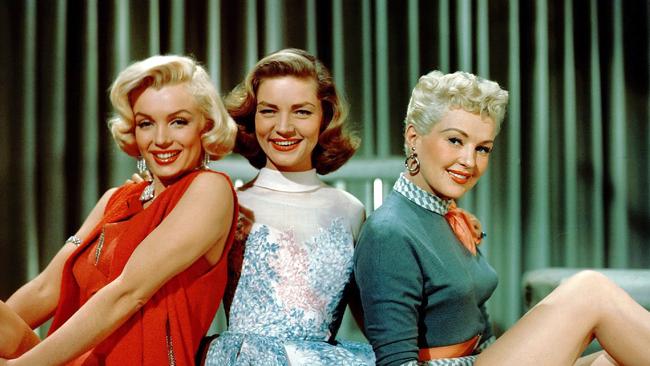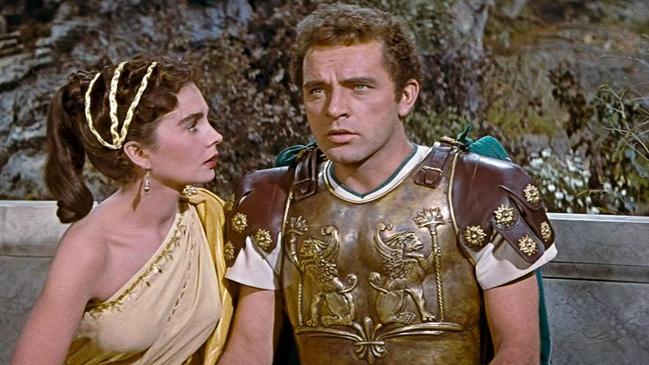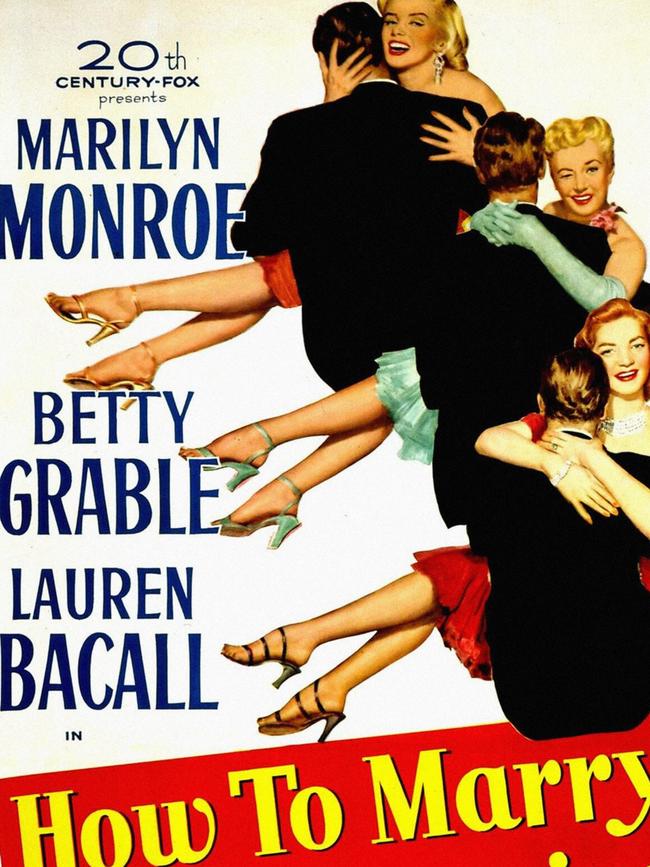David Stratton reviews How to Marry a Millionaire and The Robe
CinemaScope was invented to entice audiences away from television screens.

When I was 14 years old the cinema went through the greatest technical transformation since the coming of the talkies a quarter-century earlier. The cinema screen, until then shaped more or less like a square, became wide; very wide.
The reason for this was an attempt to compete with television, that little box that had infiltrated living rooms throughout the world. In 1953 TV sets had small screens and transmissions were in black and white, but audiences seemed happy to stay at home, save money and watch their favourite comedy sitcoms, news programs, quiz shows, serials — and black-and-white movies. The popularity of TV had led to an inexorable decline in cinema audiences, a decline that began in 1946 and, by 1953, was threatening the existence of the Hollywood film studios. The studios reacted at first by making more and more films in colour, but that wasn’t enough.
The first attempts to provide audiences with something they couldn’t see at home were left to independents. Cinerama was a big-screen experience that employed three synchronised projectors, but it was too cumbersome and too expensive to be widely used and there was only one cinema equipped with the system in each major city.
In 1952, 3D was launched with Arch Oboler’s Bwana Devil (“A Lion In Your Lap!”), but to experience the three dimensions patrons were obliged to wear cheaply made, uncomfortable glasses with red and green polarising plastic lenses, and they didn’t much like them. By the time Alfred Hitchcock made Dial M for Murder (1954) in 3D, the gimmick was out of favour and the film was generally screened “flat”.
Wide screens first emerged in 1930, soon after the introduction of sound. Raoul Walsh’s western, The Big Trail, and horror film The Bat Whispers, both made that year, were filmed in 65mm rather than the traditional 35mm; but this system was also too expensive to be used widely, especially since cinemas had only recently been obliged to pay for sound equipment.
In 1952 Darryl F. Zanuck, the boss of 20th Century-Fox, purchased an anamorphic wide-screen system that had been invented several years earlier by Frenchman Henri Chretien. Films made in this system were photographed through a special lens that compressed the image on to 35mm film; when projected in a cinema, another lens achieved the opposite effect, allowing for a “letterboxed” screen size that varied from 2.55:1 to 2.33.1 — in other words, roughly 2½ times as wide as it was high. Zanuck christened the system CinemaScope and on March 12, 1953, he announced that all Fox films would use it.
Not only that: Zanuck decreed that from then on Fox films would be made available only to cinemas that installed the wide screen and an accompanying stereophonic sound system.
In Britain, where I was living, Fox films were usually screened in cinemas owned by the Rank Organisation — Odeons and Gaumonts. But Rank baulked at the cost of installing both the new screens and new sound systems throughout its chain of cinemas, so Fox announced it was withdrawing all its product from the country’s major cinema chain.
Instead, Fox sought out top-quality independent cinemas to install CinemaScope, under the watchful eye of Fox technicians. In my case that meant the first CinemaScope film would not show at my local Gaumont cinema but at the independently owned Astoria. Fox created a great deal of publicity about its coming slate of Scope movies, which was launched with biblical epic The Robe (1953) — and I was eagerly awaiting the chance to see this new screen “miracle”, an experience, we were promised, to be enjoyed without having to wear special glasses.

The Astoria announced that The Robe would open for an unprecedented two weeks (my locals screened films for only a single week) on Friday, August 13, 1954. But that was the day we were to start our two-week annual holiday, at a small guesthouse by the sea in Cornwall. Normally I enjoyed these summer breaks, although it usually rained and the sea was numbingly cold. But this time I was devastated. I begged my parents to allow me to stay at home alone but, not surprisingly, my entreaties fell on deaf ears. In those days, once a film had played at your local cinema you might never have another chance to see it, so I was inconsolable.
Those were two miserable weeks. We returned to find that the second CinemaScope film, How to Marry a Millionaire (1953), had just opened, and my mother came with me to see it a few days later.

Compared with its previous size, the new wide screen seemed vast. The film, which I later discovered was actually the first CinemaScope production, having been filmed before The Robe, was directed by Jean Negulesco, who treated the new format nervously, rarely moving the camera, affording no close-ups, but displaying his great cast — Marilyn Monroe, Lauren Bacall and Betty Grable — spaced out at regular intervals across the width of the screen. The simple plot, based on a 1930 play, involves three bachelor girls who share a New York apartment and who are on the hunt for rich men to marry. Pola (Monroe, giving a dazzling performance) is very shortsighted but refuses to wear glasses in public, a habit that results in more than one amusing encounter. If the staging is unadventurous, the actors are excellent and the location scenes of the city extremely beautiful.
I eventually saw The Robe in 1956 at a revival cinema. I can’t claim that it was worth the wait. Based on a novel by Lloyd C. Douglas, the handsomely mounted but inert production deals with the origins of Christianity. Richard Burton plays Marcellus Gallio, a dissolute Roman officer in charge of the Crucifixion, who acquires Christ’s robe and hands it over to his slave, Demetrius (Victor Mature). Marcellus is converted to the faith by St Peter (Michael Rennie) and, together with Diana (Jean Simmons), his beloved, becomes a martyr. Distinguished by some ripe overacting by Jay Robinson, who plays Caligula, the film, despite its subject matter, is pretty uninspired, with director Henry Koster, like Negulesco, seemingly terrified to move the camera. Only Alfred Newman’s music score is of note.
The whole point of Scope films was to offer cinema audiences something they couldn’t see on the small screen. Ironically, then, in 1960 How to Marry a Millionaire became the first Scope film to screen on American TV, where it was “panned and scanned”, a ghastly system that in effect re-edited and destroyed the film to fit it into the confines of a small, square TV screen. Panning and scanning is how Scope films were shown until the advent of DVDs. Wide screens are still with us — the shape of our TV screens has widened to accommodate them.
In 1957, 20th Century-Fox decided to return its product to Rank cinemas, abandoning the independents that had supported the company in launching CinemaScope. Peyton Place was the first Fox film screened by Rank cinemas when the status quo was restored. The Astoria closed its doors forever not long afterwards.
How to Marry a Millionaire screens on Foxtel. The Robe is available to rent or buy on iTunes.
READ MORE: WATCH: Colin Hay in the Isolation Room | David Stratton remembers: Hitchcock’s The Birds

